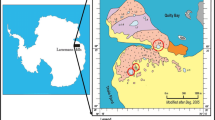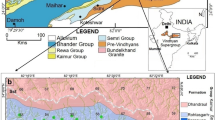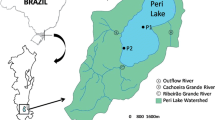Abstract
The Late Miocene fine-grained deposits have been investigated in the Vienna Basin to attest oxygen availability for infauna and epifauna in the sublittoral of the long-lived Lake Pannon. A clay and fine silt of the deeper lacustrine facies of a bay passed vertically into a silty clay, silt, and fine sand rhythmic deposition reflecting successive progradation of brackish prodelta to distal delta front colonized by a dense benthic population. A fully oxygenated environment is supposed in the Congeria subglobosa Beds and prodelta accentuated by ichnofauna, ostracods, and abundant in taxa and specimens, low total organic content, and trace elements concentration. A limited anoxic event caused by temporarily worsened circulation has been detected in non-calcareous greyish-blue homogenous clay with a noticeable high concentration of Ni, Co, and Pb coupled with absence of fossils, bioturbation, and low total organic carbon content.








Similar content being viewed by others
References
Babinszki E, Sztanó O, Magyari Á (2003) Episodic deposition in the Kálla bay of Lake Pannon: sedimentology and trace fossils of Kálla Sand. Földtani Közlöny 133:363–382
Bird FL, Boon PI, Nichols PD (2000) Physicochemical and microbial properties of burrows of the deposit-feeding thalassinidean ghost shrimp Biffarius arenosus (Decapoda: Callianassidae). Estuar Coast Shelf Sci 51:279–291
Bishop GA, Williams AB (2005) Taphonomy and preservation of burrowing thalassinidean shrimps. Proc Biol Soc Wash 118:218–236
Bodergat A, Ishizaki K, Oki K, Rio M (2002) Currents, civilization, or volcanism? Ostracodes as sentinels in a patchy environment: Kagashima Bay, Japan. Micropaleontology 48:285–299
Brenchley PJ (1985) Storm influenced sandstone beds. Modern Geol 9:369–396
Bromley RG (1996) Trace fossils: biology, taphonomy and applications, 2nd edn. Chapman & Hall, London, p 361
Bromley RG, Ekdale AA (1984) Chondrites: a trace fossil indicator of anoxia in sediments. Science 224:173–174
Buck SG, Goldring R (2003) Conical sedimentary structures, trace fossils or not? Observations, experiments, and review. J Sediment Res 73:338–353
Cohen AS (2003) Paleolimnology. The history and evolution of lake systems. Oxford University Press, Oxford, p 500
Cziczer I, Magyar I, Pipík R, Böhme M, Ćorić S, Bakrač K, Sütő-Szentai M, Lantos M, Babinszki E, Müller P (2009) Life in the sublittoral zone of Lake Pannon: paleontological analysis of the Upper Miocene Szák Formation. Int J Earth Sci 98:1741–1766
Danielopol DL, Geiger W, Tölderer-Farmer M, Orellana CP, Terrat MN (1988) In search of Cypris and Cythere—a report of the evolutionary ecological project on limnic Ostracoda from the Mondsee (Austria). In: Hanai T, Ikeya N, Ishizaki K (eds) Evolutionary biology of ostracoda, its fundamentals and applications. Elsevier, Kodansha, pp 485–500
Danielopol DL, Casale L, Rogulj B, Strobl J, Maier K (1990) Spatial distribution of Cytherissa lacustris living in Mondsee. Bull Inst Géol Bassin d’Aquitaine 47:139–165
Einsele G, Seilacher A (1982) Paleogeographic significance of tempestites and periodites. In: Einsele G, Seilacher A (eds) Cyclic and event stratification. Springer, Berlin Heidelberg New York, pp 531–536
Frey RW, Curran AH, Pemberton GS (1984) Tracemaking activities of crabs and their environmental significance: the ichnogenus Psilonichnus. J Paleontol 58:511–528
Gamenick I, Jahn A, Vopel K, Giere O (1996) Hypoxia and sulphide as structuring factors in a macrozoobenthic community on the Baltic Sea shore: colonisation studies and tolerance experiments. Mar Ecol Progr Ser 144:73–85
Harzhauser M, Mandic O (2004) The muddy bottom of Lake Pannon–a challenge for dreissenid (Late Miocene; Bivalvia). Palaeogeogr Palaeoclimatol Palaeoecol 204:331–352
Harzhauser M, Piller WE (2007) Benchmark data of a changing sea—Palaeogeography, palaeobiogeography and events in the Central Paratethys during the Miocene. Palaeogeogr Palaeoclimatol Palaeoecol 253:8–31
Harzhauser M, Tempfer PM (2004) Late Pannonian wetland ecology of the Vienna Basin based on molluscs and lower vertebrate assemblages (Late Miocene, MN 9, Austria). Courier Forschungsinstitut Senckenberg 246:55–68
Harzhauser M, Ch Latal, Piller WE (2007) The stable isotope archive of Lake Pannon as a mirror of Late Miocene climate change. Palaeogeogr Palaeoclimatol Palaeoecol 249:335–350
Harzhauser M, Kern A, Soliman A, Minati K, Piller WE, Danielopol DL, Zuschin M (2008) Centennial- to decadal scale environmental shifts in and around Lake Pannon (Vienna Basin) related to a major Late Miocene lake level rise. Palaeogeogr Palaeoclimatol Palaeoecol 270:102–115
Jiříček R (1985) Die Ostracoden des Pannonien. In: Papp A (ed) Chronostratigraphie und Neostratotypen, Miozän der Zentral Paratethys, Bd. VII, M6 Pannonien (Slavonien und Serbien). Akadémiai Kiado, Budapest, pp 378–408
Jiříček R (1990) Fluvial and deltaic systems of Neogene Paratethys. Konferencie, Sympózia, Semináre, 50 rokov výuky geológie a paleontológie na Slovensku. Geologický ústav Dionýza Štúra, Bratislava, pp 79–88 [in Czech with English Abstract]
Jiříček R (2002) The evolution of the molasse in the Alpino-Carpathian Foredeep and the Vienna Basin. Exploration geophysics, remote sensing and environment IX: 1–2, CAAG—Praha, pp 178 [in Slovak with abstract in English]
Juhász G, Magyar I (1992) Review and correlation of the Late Neogene (Pannonian s.l.) lithofacies and mollusc biofacies in the Great Plain, eastern Hungary. Földtani Közlöny 122:167–194
Kaesler RL, Kontrovitz M, Taunton S (1993) Crushing strength of Puriana pacifica (Ostracoda), an experimental approach to taphonomy. J Paleontol 67:1005–1010
Kontrovitz M (1967) An investigation of ostracode preservation. Quart J Florida Acad Sci 29:171–177
Kováč M, Baráth I (1995) Tectono-sedimentary development of the Alpine-Carpathian-Pannonian junction zone during the Miocene (in Slovak with abstract in English). Mineralia Slovaca 28:1–13
Kováč M, Baráth I, Kováčová-Slamková M, Pipík R, Hlavatý I, Hudáčková N (1998) Late Miocene paleoenvironments and sequence stratigraphy: northern Vienna Basin. Geologica Carpathica 49:445–458
Kováč M, Fordinál K, Halásová E, Hudáčková N, Joniak P, Pipík R, Sabol M, Kováčová-Slamková M, Sliva Ľ (2005) Western Carpathian fossil ecosystems and their relation to Neogene evolution of Euro-Asian continent (in Slovak). Geologické práce, Správy 111:61–121
Krstić N (1971) Ostracodes biofacies in the Pannone. In: Oertli HJ (ed) Paléoécologie des Ostracodes, vol 5. Bull Centre Rech, pp 391–397
Lellák J, Kubíček F (1991) Hydrobiologie (in Czech). Univerzita Karlova—Karolinum, Praha, p 260
Maddocks RF (1988) One hundred million years of predation on ostracods: the fossil record in Texas. In: Hanai T, Ikeya N, Ishizaki K (eds) Evolutionary biology of ostracoda, its fundamentals and applications. Elsevier, Kodansha, pp 637–657
Magyar I, Geary DH, Müller P (1999) Paleogeographic evolution of the Late Miocene Lake Pannon in Central Europe. Paleogeogr Paleoclimatol Paleoecol 147:151–167
Magyar I, Müller PM, Sztanó O, Babinszki E, Lantos M (2006) Oxygen-related facies in Lake Pannon deposits (Upper Miocene) at Budapest-Köbánya. Facies 52:209–220
Magyar I, Lantos M, Ujszaszi K, Kordos L (2007) Magnetostratigraphic, seismic and biostratigraphic correlations of the Upper Miocene sediments in the northwestern Pannonian basin system. Geol Carpath 58:277–290
Martens K (1994) Ostracod speciation in ancient lakes: a review. In: Martens K, Goddeeris B, Coulter G (eds) Speciation in ancient lakes, vol. 44. Arch Hydrobiol, Beih Ergebn Limnol, pp 203–222
Meisch C (2000) Freshwater Ostracoda of Western and Central Europe. Spektrum Akademischer Verlag, Heidelberg, p 522
Moretti M, Sabato L (2007) Recognition of trigger mechanisms for soft-sediment deformation in the Pleistocene lacustrine deposits of the Sant′Arcangelo Basin (southern Italy): seismic shock vs. overloading. Sediment Geol 196:31–45
Myrow PM, Southard JB (1996) Tempestite deposition. J Sed Res 66:875–887
Oertli HJ (1971) The aspect of ostracode faunas—a possible new tool in petroleum sedimentology. In: Oertli HJ (ed) Paléoécologie des Ostracodes, vol 5. Bull Centre Rech, Pau—SNPA, pp 137–151
Owen G (1987) Deformation processes in unconsolidated sands. In: Jones ME, Preston RMF (eds) Deformation of sediments and sedimentary rocks, vol 29. Geol Soc Spec Publ Lond, pp 11–24
Papp A (1951) Das Pannon des Wiener Beckens. Mitt Geol Gesell in Wien 1946: 39–41 and 1948: 99–193
Pipík R (1998) Salinity changes recorded by Ostracoda assemblages found in Pannonian sediments in the western margin of the Danube Basin. Bull Centres Rech Explor-Prod Elf-Aquitaine 20:167–177
Pipík R (2007) Phylogeny, palaeoecology, and invasion of non-marine waters by the Late Miocene hemicytherid ostracod Tyrrhenocythere from Lake Pannon. Acta Palaeont Pol 52:351–368
Pipík R, Fordinál K, Slamková M, Starek D, Chalupová B (2004) Annotated checklist of the Pannonian microflora, evertebrate and vertebrate community from Studienka, Vienna Basin. Scripta Fac Sci Nat Univ Masaryk Brunensis. Geology 31–32(2001–2002):47–54
Pokorný V (1952) The ostracods of the so-called basal-horizon of the Subglobosa Beds at Hodonín (Pliocene, Inner Alpine Basin, Czechoslovakia) (in Czech with Russian and English abstracts). Sborník Ústředního ústavu geologického 19:229–396
Reineck HE, Singh IB (1980) Depositional sedimentary environments, 2nd edn. Springer, Berlin Heidelberg New York, p 551
Ruiz F, Abad M, Bodergat AM, Carbonel P, Rodríguez-Lázaro J, Yasuhara M (2005) Marine and brackish-water ostracods as sentinels of anthropogenic impacts. Earth-Sci Rev 72:89–111
Ruiz F, Abad M, Olías M, Galán E, González I, Aguilá E, Hamoumi N, Pulido I, Cantano M (2006) The present environmental scenario of the Nador Lagoon (Morocco). Environ Res 102:215–229
Savrda ChE, Bottjer DJ (1986) Trace-fossil model for reconstruction of paleo-oxygenation in bottom waters. Geology 14:3–6
Schaller T, HCh Moor, Wehrli B (1997) Sedimentary profiles of Fe, Mn, V, Cr, As and Mo as indicators of benthic redox conditios in Baldeggersee. Aquat Sci 59:345–361
Sims JD (1973) Earthquake-induced structures in sediments of Van Norman Lake, San Fernando, California. Science 182:161–163
Skei JM, Loring DH, Rantala RTT (1996) Trace metals in suspended particulate matter and in sediment trap material from a permanently anoxic fjord–Framvaren, South Norway. Aquat Geochem 2:131–147
Vakarcs G, Vail PR, Tari G, Pogácsás Gy, Mattick RE, Szabó A (1994) Third-order Middle Miocene-Early Pliocene depositional sequences in the prograding delta complex of the Pannonian Basin. Tectonophysics 240:81–106
Van Straaten LMJU (1959) Littoral and submarine morphology of the Rhone Delta. In: Russell RJ (ed) 2nd coastal geographic conference, Baton Rouge, Proceedings; National Academy of Science, National Research Council, pp 233–264
Vass D (2002) Litostratigrafia Západných Karpát: neogén a budínsky paleogén. Štátny geologický ústav Dionýza Štúra, Bratislava, p 202
Waeles M, Riso RD, Le Corre P (2005) Seasonal variations of cadmium speciation in the Penzé estuary, NW France. Estuar Coast Shelf Sci 65:143–152
Wesselingh FP, Kaandorp RJG, Vonhof HB, Räsänen ME, Renema W, Gingras M (2006) The nature of aquatic landscapes in the Miocene of western Amazonia: an integrated palaeontological and geochemical approach. Scripta Geol 133:363–393
Wetzel RG (2001) Limnology, lake and river ecosystems, 3rd edn. Academic Press, San Diego, p 1006
Yin Y, Geiger W (1995) Spatial distribution of ostracods related to abiotic factors in Mooswinkl Bay, Mondsee, Austria. In: Říha J (ed) Ostracoda and biostratigraphy. AA Balkema, Rotterdam, pp 381–387
Acknowledgments
This work was supported by the APVV agency (project APVT-51-045202 and APVV-0109-07). We are grateful to Prof. Kováč and Dr. Sliva from Comenius University for their palaeogeographical comments, Dr. Šimo from Slovak Academy of Sciences for his comments to chapter Ichnofossils and Alžbeta Svitáčová from Slovak Academy of Sciences for technical help. Thanks are also extended to two anonymous reviewers for their constructive comments, which improved the manuscript.
Author information
Authors and Affiliations
Corresponding author
Rights and permissions
About this article
Cite this article
Starek, D., Pipík, R. & Hagarová, I. Meiofauna, trace metals, TOC, sedimentology, and oxygen availability in the Late Miocene sublittoral deposits of Lake Pannon. Facies 56, 369–384 (2010). https://doi.org/10.1007/s10347-009-0208-2
Received:
Accepted:
Published:
Issue Date:
DOI: https://doi.org/10.1007/s10347-009-0208-2




